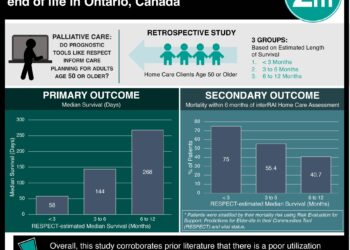End of life care disparities reported among several developed nations
1. Among patients older than 65 years of age who died with cancer in 2010, rates of end-of-life acute hospitalization differ widely across several developed nations, and are highest in Belgium, Canada, Germany, England, and Norway.
2. Hospital expenditures near end-of-life also vary widely, independent of hospitalization rate, and are highest in the United States, Norway, and Canada.
Evidence Rating Level: 2 (Good)
Study Rundown: Health care utilization is a topic of considerable policy importance in many nations around the world. However, when it comes to end-of-life care, comparable data between nations remains sparse, and previous studies on the topic have yielded limited and often contradictory results. Therefore, the purpose of this study was to investigate, in a rigorous way, the diverse end-of-life care practices and resulting outcomes among several developed nations, including Belgium, Canada, England, Germany, the Netherlands, Norway, and the United States.
The results of this study demonstrate that the practices and outcomes of end-of-life care reflect the internal policies of the respective countries. For instance, the United States and the Netherlands were shown to have the lowest proportion of patients dying in hospital. The United States has thousands of hospice and home-care facilities designed for end-of-life care and the Netherlands actively promotes palliative and home-based care. Regarding costs, the United States and Belgium have relatively high hospital expenditures during end-of-life care, and much of this effect can be explained by greater rates of chemotherapy use at the end of life in these countries.
Key limitations of the study include the six year gap between data collection and study publication, and the few number of developed countries evaluated (7 out of ~80 developed countries in the world). While reports comparing healthcare practices of large economies are rare and often difficult to conduct, the narrow focus of this study helped to uncover trends in end-of-life care that may serve to inform healthcare policies moving forward.
Click to read the study in JAMA
Relevant Reading: Managed care, hospice use, site of death, and medical expenditures in the last year of life
In-Depth [retrospective cohort study]: This retrospective study evaluated decedents between January 1, 2010 and December 31, 2010 who had a cancer diagnosis documented within 180 days prior to death. All subjects were from Belgium, Canada, England, Germany, the Netherlands, Norway, or the United States. The highest rates of death in acute care hospitals occurred in Belgium (n = 21,054; death in acute care hospital, 51.2%), Canada (n = 20,818; 52.1%), England (n = 97,099; 41.7%), Germany (n = 24,434; 38.3%), and Norway (n = 6,636; 44.7%). In the last 180 days of life, per capita hospital expenditures were highest in Canada (US $21,840), Norway (US $19,783), and the United States (US $18,500). In the last 180 days of life, the United States (38.7%) and Belgium (33%) demonstrated the highest rates of chemotherapy utilization.
Image: PD
©2016 2 Minute Medicine, Inc. All rights reserved. No works may be reproduced without expressed written consent from 2 Minute Medicine, Inc. Inquire about licensing here. No article should be construed as medical advice and is not intended as such by the authors or by 2 Minute Medicine, Inc.







